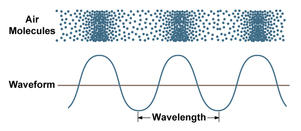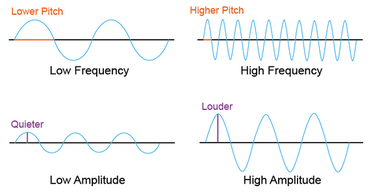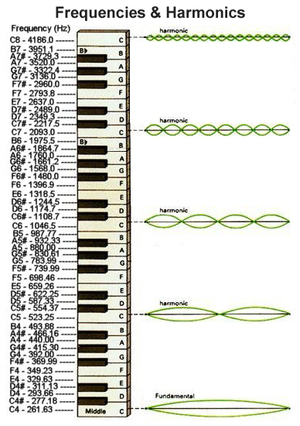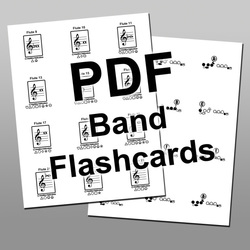|
The musical interval of an octave can also be referred to as a Perfect Octave, or an eighth. It is fairly obvious that the word means 8 of something, so 8 whats? It does not mean 8 steps, because it is really 7 steps away...specifically 5 whole steps and 2 half steps. If you are playing chromatically, then the octave is 12 half steps away. So, the 8 does not come from the number of notes you have to play to arrive at the right note, it really means "the 8th" note in a scale in which you count the starting note as "1" and the next note as "2", and so forth. Have you ever noticed that there are only 7 letters used in the musical alphabet? A-G, right? So, if you start on "A" and think of it as "1", then count up through B, C, D, E, F, and G, then you have to use "A" again to get to "8". It doesn't matter whether you are using a major scale, minor scale, or any other type of scale. As long as you only use each letter once (with any combination of sharps or flats) you will arrive at the same letter that you started with for the 8th note. This brings up an interesting question: Why is the octave so important that it caused early musicians to base the whole system of music theory on 7 note names? (Remember, 7 note names + 1 repeated note name = 8, or the octave) The answer is complicated, but I will give a somewhat simplified answer.  A musical tone can be measured in terms of its wavelength. Any sound causes a ripple or "wave" through the gaseous molecules that make up the air in our atmosphere. One molecule bumps into another, which bumps into another and so forth as the sound travels through the air. A musical tone, unlike other "sounds" or "noises" has a steady pulse of waves. Because the wave pulses are steady, they have a regular, exact, measurable distance between the start of one wave and the start of the next one. This is called the wavelength. When we graph a musical wave we draw a curvy line which goes up and down and up and down... We then show the wavelength as being the distance from one point on the "wave" to the correlating point on the next adjacent wave. Interestingly, the distance from the bottom of the wave to the top is used to show how LOUD a sound is (or the sound's amplitude).  Are you still following me? Okay, the next part is the really important part. When you make a musical tone that has exactly 1/2 the wavelength of an existing tone, you create the OCTAVE. The first tone might be a middle C with a wavelength of approximately 130 centimeters, and so the next C after going through 7 other letters (D, E, F, G, A, and B) has a wavelength of...drum roll please...65 centimeters! Make sense? (For a nice list of the wavelengths of all musical pitches, visit this site: http://www.phy.mtu.edu/~suits/notefreqs.html) In other words, the higher-octave C has a wave that is exactly half the length of the original middle C, meaning TWO wave shapes of the higher-octave C fits PERFECTLY in the wave shape of the lower C. Another way to talk about this phenomenon is in terms of frequency, which describes how many times a wave oscillates per second (in Hertz), and therefore has an inverse relationship to wavelength. A large wavelength = a low frequency, and a small wavelength = a high frequency, as shown in the Frequencies & Harmonics chart below. Also shown in the chart below is that for each octave the frequency is exactly double the previous one.  This is why octaves sound SO GOOD together...because the crests of the sound waves line up as you play the two pitches together. On the other hand, if you play two sounds that are not an octave apart, then the sound waves do not line up or match at every crest. The resulting "harmony" or "dissonance" (depending on the interval) is the result of two waves that do not match up very well. Each time two waveforms do match up every 2-6 oscillations, the one with the shorter wavelength can be called a "harmonic" of the other wave, and its wavelength will always be a simple ratio of the other wavelength, such as 1/2, 2/3, or 3/4. Cool! Octaves match up in this way very nicely, and sound so similar that early musical theorists decided to give them the SAME LETTER NAME! Wouldn't it be horrible to have an 88-key piano which had to have 88 different note names...one for each key? I can't imagine the mess that would be! Instead, as we play from left to right on the piano keys, every once in a while we reach a note that has half the wavelength of a previous note and we can call it by the same name. Until someone invents a better system of organizing and naming all the different notes...I can live with A,B,C,D,E,F, and G repeated over and over!
0 Comments
Leave a Reply. |
Author
Curtis Winters has taught band, orchestra, and jazz band at a small Title 1 junior high school in Orem, UT for 18 years. Archives
May 2018
Categories
|
|
StepWise Publications
896 W 2370 N Provo, UT 84604 curtis@stepwisepublications.com |


 RSS Feed
RSS Feed

